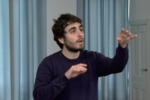legerdemain
Susanne Bürner

![]()
Susanne Bürner
curated by Ingeborg Erhart
Four people play a part in the three-channel video installation legerdemain. A woman is the first to appear. She is followed by an older man with shoulder-length white hair and two young men, an Asian and a southern European type. Divided between three projections, they seem to be communicating with each other in a special way, firmly based on gestures, and to instigate mutual responses. After some time it becomes clear that the protagonists are all conductors who are not using batons.
Susanne Bürner filmed them at work, then removed the contexts by isolating them from their respective orchestras; she then set them in a new context in which they are – apparently – reacting to each other. The woman turns in a semicircle, indicating the sequence of cues. She is mistress of ceremonies and the presenter of what is going on. The two young men fight out a battle; they are in competition with one another. By contrast, the older man keeps his countenance and seems entirely at peace with himself. For the soundtrack, reverting to a technique dating from the early period of film and – comparable to the live accompaniment to silent movies – Susanne Bürner asked three musicians to improvise to the images. Using harpsichord, piano, trombone and DJ effects such as scratching, they underline the performers’ assumed character traits. At visits to the Berlin Philharmonic and other concerts, Susanne Bürner observed the setting, fascinated by the role of the conductor and the fact that the smallest of movements could trigger major responses. The profession has strong connotations with power but has only existed since the first half of the 19th century, after which different types soon developed: “self-stagers, magicians, eccentrics, humanists and the scrupulous.” 1 Such roles were probably inspired by the dominant contemporary ideals of creativity, power, masculinity and leadership style, but the debate over appearance was omnipresent in the reception of conductors from the very beginning.2
Much has changed in the meantime, at least with respect to the power divide between conductors and musicians, and there are very few absolute rulers of the old school left. Of course, it has always been and still is a matter of how the orchestral or choral director influences the musicians. Because this occurs by means of body language, there is always something very expressive about conducting. Or are there additional, psychic connections? “The conductor should transport his consciousness into the musicians’ collective unconscious.” 3
In legerdemain Susanne Bürner leaves open the question of how this might happen. However, the title of the work gives some indication that the artist may take the supernatural into consideration. “legerdemain” is a rarely used term – at least in US American – which comes from the French and incorporates the words “light” (léger) and “hand” (la main). Synonymous with the work of sorcerers. It’s magic!4
In Susanne Bürner’s solo exhibition of the same name in the Neue Galerie of the Tiroler Künstler*schaft it was possible to see two other works made in the context of her investigation into the theme of conducting. Photographs in glowing colors, printed on thin silk reminiscent of flags or a magician’s scarves, each showed two isolated hands, graphically highlighted, which were also interrelated. Conducting without a baton, according to the artist, means that both hands are of equal importance. In the display case in front of the gallery entrance there was a collage made from copies of an edition printed on newsprint, which had been published by Boabooks on the occasion of a screening with an artist talk at Printed Matter Inc. in New York in July that year; it also explored the way the highlighted hands interact. Besides her latest works, Susanne Bürner was also showing the photo series Vampyr from 2007. As in the three-channel video legerdemain and the spatial installation, curtains play an important part as a dramaturgical element here, too. People pass in front of them in a kind of procession against back lighting. The pictures were taken at documenta 12 in Kassel, 2007, when curators Roger Buergel and Ruth Noack proposed, among others, the leitmotif “Is Modernity Our Antiquity?” and also showed historical art alongside the contemporary. For reasons of of contemplating art.” This “being led” resulted in the choice of title for the series and also to the artist’s enthusiasm for the stylistic means of schematic figures in back-lit windows and the heavy accentuation of shadows, which were employed in the making of the 1932 film Vampyr. The photo work should be seen as a homage to the Danish director Carl Theodor Dreyer’s first sound movie, whose exaggerated physicality, sparse dialogues and intermittent text frames still firmly link it to the genre of silent film.
For a long time now Susanne Bürner has been concerned with the themes of absence and disappearance, with central questions of (subjective) perception and visual depictability. The latest works and this exhibition told of physical mediation and mystic shadows, which came to nothing as they were faded out or the contexts were shifted. They dealt with representational forms of the invisible in physical and psychic spaces, playing with their emotional dimensions.
1 Wolfgang Hattinger, Der Dirigent – Mythos, Macht, Merkwürdigkeiten [The Conductor: Myth, Power, Peculiarities], www.br.de/radio/br-klassik/sendun-gen/leporello/buchtipp-der-dirigent-hattinger100.html, November 4, 2015
2 Cf. Holly Mathieson, Embodying Music: The Visuality of Three Iconic Conductors in London, 1840-1940, Embodying Music: The Visuality of Three Iconic Conductors in London, 1840-1940, Abstract, ii ff, 04.11.2015.
3 Hattinger, ibid.
4 Note by IE: answer from Marina Vishmidt, fellowship holder of the International Fellowship Program in Künstlerhaus Büchsenhausen 2015-16, living in London, when asked whether she knew the term “legerdemain”.
Exhibition booklet (in German)







